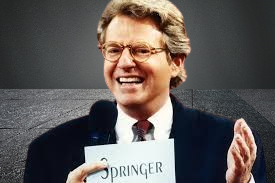
Few television personalities have captured the public’s attention quite like Jerry Springer. Known primarily as the host of The Jerry Springer Show, his name became synonymous with outrageous drama, shocking revelations, and often chaotic scenes that bordered on the surreal. While the tabloid talk show brought him international fame, there is much more to the man than chair-throwing and on-screen brawls. A documentary exploring Jerry Springer’s life—his humble beginnings, rise to fame, and complex legacy—reveals the fascinating layers of a man who transcended his public persona. This article delves into the themes and revelations such a documentary might cover, offering a deeper understanding of Springer’s life, career, and enduring impact.

Early Life: From Refugee to Political Aspirations
Gerald Norman Springer was born on February 13, 1944, in London, England, to Jewish refugees who fled Nazi Germany. His early life was shaped by the horrors of World War II, a reality that instilled in him a deep sense of resilience and purpose. In the documentary, this formative period is likely to be explored as a driving force behind Springer’s commitment to social justice and his initial foray into politics. Springer’s family immigrated to the United States when he was just five years old, settling in Queens, New York.
He went on to earn degrees in political science and law, demonstrating early on that he was ambitious and highly intelligent. His passion for public service culminated in a political career that saw him serve as a councilman and later as the mayor of Cincinnati in the 1970s. Springer’s political ambitions were promising, but his career took an unexpected turn after a scandal involving a personal indiscretion. This turning point is likely a pivotal moment in the documentary, highlighting how he transitioned from politics to a career in broadcasting.
The Rise of The Jerry Springer Show
When The Jerry Springer Show debuted in 1991, it was far from the sensationalist spectacle it would later become. Initially conceived as a serious talk show tackling social and political issues, it struggled to find an audience. Faced with declining ratings, producers revamped the format, leaning into sensationalism and conflict. This decision proved to be a game-changer. The documentary would likely delve into how Springer adapted to this shift, embracing the show’s new identity while grappling with its polarizing reception.

Critics lambasted the program for its perceived exploitation of human suffering, but audiences couldn’t look away. By the mid-1990s, The Jerry Springer Show was a cultural phenomenon, often outperforming rivals like The Oprah Winfrey Show in ratings. Through interviews and archival footage, the documentary could explore iconic moments from the show, such as dramatic confrontations, bizarre confessions, and the infamous chant of “Jerry! Jerry!” that became synonymous with the host. Springer’s role as the ringmaster of this circus-like environment would also be examined, shedding light on how he balanced the absurdity of the show with his trademark wit and charm.
The Cultural Impact of The Jerry Springer Show
While The Jerry Springer Show was often dismissed as lowbrow entertainment, its influence on pop culture cannot be overstated. The show tapped into the zeitgeist of the 1990s and early 2000s, reflecting societal shifts in how people consumed media and viewed tabloid-style storytelling. The documentary might analyze how Springer’s show paved the way for reality television, which thrives on drama and voyeurism.
Programs like Keeping Up with the Kardashians and Jersey Shore owe a debt to Springer’s groundbreaking approach, as do modern talk shows that blur the line between entertainment and shock value. At the same time, The Jerry Springer Show sparked debates about the ethical implications of exploiting personal turmoil for public consumption. Critics questioned whether the show perpetuated harmful stereotypes and trivialized serious issues. These discussions would make for a compelling segment in the documentary, examining Springer’s legacy within the broader context of media ethics.

Behind the Scenes: The Man Versus the Persona
One of the most intriguing aspects of a Jerry Springer documentary would be the contrast between his on-screen persona and his real-life character. Despite the chaos of his show, Springer was known to be remarkably grounded and self-aware. He often joked about his role, famously quipping, “I’m the host of the worst television show in history.” The documentary could include interviews with friends, colleagues, and family members who offer insight into Springer’s off-camera life.
Viewers would learn about his philanthropic efforts, including his support for various charities and advocacy for progressive causes. These aspects of his life paint a picture of a man who was much more than a TV personality. Additionally, Springer’s forays into other areas of entertainment—such as his brief stint as a ballroom dancer on Dancing with the Stars and his work as a political commentator—showcase his versatility and willingness to step outside his comfort zone.

Jerry Springer’s Legacy
Jerry Springer passed away on April 27, 2023, leaving behind a legacy that is as complex as it is enduring. For better or worse, he changed the landscape of television, pushing boundaries and challenging societal norms. A documentary about his life would likely explore how Springer reconciled his reputation as a provocateur with his personal values. It would also consider the ways in which his show reflected—and perhaps shaped—the cultural and political climate of its time.
In reflecting on Springer’s impact, the documentary could pose larger questions about the role of media in society. Is sensationalism an inevitable byproduct of entertainment, or does it have a deeper purpose in giving voice to marginalized stories? Springer’s life and career provide fertile ground for such discussions.
Conclusion
“Jerry Springer: The Man Behind the Madness” would offer an intimate and thought-provoking look at one of television’s most controversial figures. Through a blend of archival footage, candid interviews, and expert analysis, the documentary would go beyond the chaos of The Jerry Springer Show to uncover the man who became a cultural icon. Jerry Springer’s story is one of reinvention, resilience, and the enduring power of entertainment to captivate and challenge audiences. As viewers peel back the layers of his life, they would come to understand that behind the madness was a man of remarkable intelligence, empathy, and wit—a man who left an indelible mark on television and pop culture.







2 thoughts on “Jerry Springer: The Man Behind the Madness – A Documentary Insight”